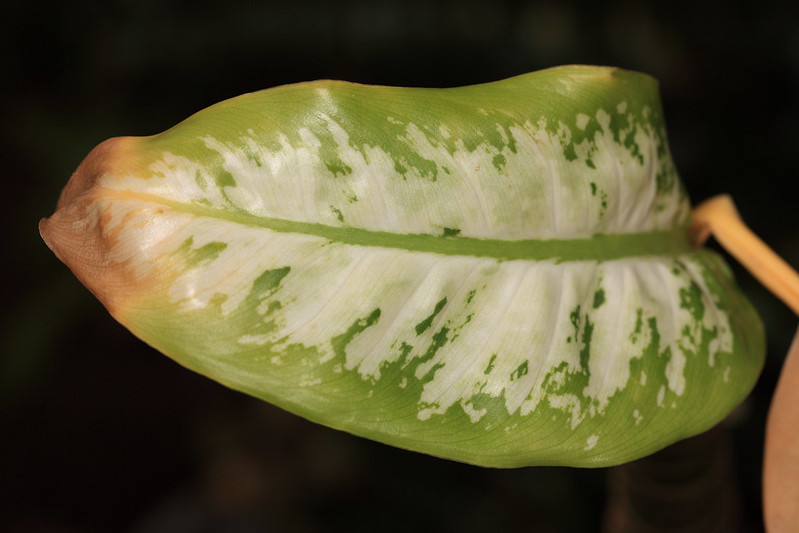Dieffenbachia Is Dying
Dieffenbachia plants are some of the most impressive and easiest tropical houseplants to grow. They tolerate and even thrive in almost any light level, except full sun exposure. Dieffenbachia are not hungry plants and do not need extensive fertilizing programs to keep them healthy and looking their best. Watering is the only cultural technique that may cause problems, be that underwatering or overwatering.
Drooping and yellowing leaves can mean many different things for plants. Drooping in Dieffenbachia indicates sunlight or watering issues. Move the plant to a different location with either lower light levels or more direct sun exposure. The plant should respond quickly and begin to grow better in 1-2 days. Over-watered plants may be sitting in excessive water in a cache pot or saucer and need better drainage.
Repotting into a better draining pot and fresh potting soil should reverse any damage caused by too much water. Underwatering or dehydration is also easily fixed. Increasing the humidity levels near the plant and watering on a regular schedule is often all that is needed to encourage fresh new growth from Dieffenbachia.

Dieffenbachia Leaves Turning Yellow
Leaves can turn yellow due to many factors. Over or underwatering are the most common reasons. Overwatering can cause leaves and stems to become squishy and yellow. The leaves can also turn yellow from underwatering, but they will eventually crisp and brown if the plant is neglected long enough. Water Dieffenbachia thoroughly until water runs from the bottom of the pot. Always discard any standing water in the drain tray or cache pot after watering.
Proper levels of humidity will also help plants use soil moisture more efficiently. Try to keep the humidity levels around 50% by misting Dieffenbachia daily with a micro-mist bottle or running a cool mist humidifier in the room. Houseplants that are grouped together in a single area maintain higher humidity levels amongst themselves.
Low room temperatures may also cause yellowing leaves. Dieffenbachia prefers warmer temperatures year-round. Keep indoor temperatures at 65-75 degrees F during the daytime and no colder than 60 F at night. Tropical plants naturally shed their leaves after they turn yellow. Expect the plant to lose the lower and oldest leaves during this period. Any new foliage that is yellowing is most likely affected by something else.
Dieffenbachia Pests
The most common pests that afflict Dieffenbachia are spider mites, scale insects, and mealybugs. All three of these pests feed on the sap of the plant and are more likely to show up when humidity levels drop during the winter months. Plants growing in low light or showing signs of stress are more susceptible to an infestation than healthy-growing and happy plants. Inspect houseplants regularly to ensure that an infestation is quickly treated and not spread to other plants. Signs of a severe infestation include webbing in the crotches of the stems and foliage (spider mites), wooly white coating on stems or leaf petioles (mealybugs and scale insects), or extensive yellowing of leaves or stunted new growth; the plant may not recover at this stage. Do not use insecticidal sprays intended for outdoor plants in the home. Look for insecticidal soaps that are specifically formulated for houseplants and use indoors.
Dieffenbachia Diseases
The most common diseases in Dieffenbachia are directly related to watering issues. Watering overhead can increase the risk of fungal leaf spot and bacterial leaf spot diseases if the foliage regularly. Dark brown or black rings start in the center of the leaves and grow until the whole leaf dies. In the case of fungal leaf spot, fungal spores develop inside the circles and will spread to nearby plants if not treated.

Photo by Tanaka Juuyoh, unmodified, Flickr, copyright CC BY 2.0 DEED
Overfertilizing houseplants can also cause disease and eventual leaf death. Too much fertilizer can lead to a buildup of salts in the soil. The excess salts can cause browning of the leaf tip and margins, eventually spreading across the whole leaf. The best remedy is to change the potting soil and switch to a slow-release fertilizer, following the recommendations of the manufacturer.
Dieffenbachia Not Blooming
Many varieties of Dieffenbachia bloom in their native jungle habitats of Mexico, Central and South America. Getting one of these tropical plants to bloom in your home is generally unsuccessful. Allowing your Dieffenbachia to spend the summer months outdoors sometimes results in blooming. The single-flower bloom is not scented and is very inconspicuous amongst the large variegated foliage. Regular fertilizing with a balanced houseplant feed during active growth in the summer months may also encourage sporadic blooming.

Photo by Maja Dumat, unmodified, Flickr, copyright CC BY 2.0 DEED
 |
Author Robbin Small - Published 12-01-2023 |
